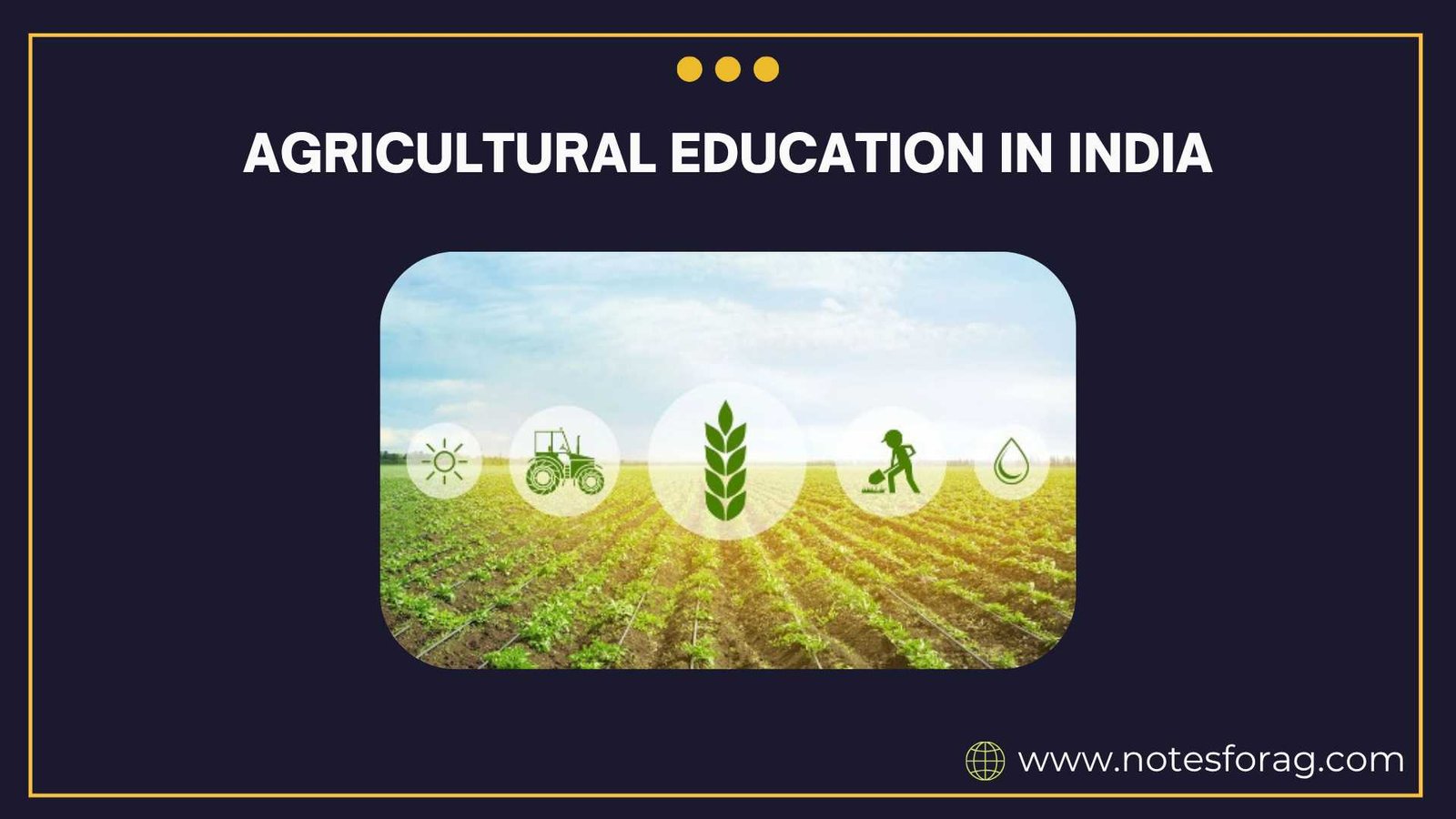INTRODUCTION TO AGRICULTURAL EDUCATION

Agricultural education in India plays a vital role in the overall development of the agricultural sector, which is the backbone of the country’s economy. With more than 50% of the population depending on agriculture for their livelihood, the need for systematic education in agriculture becomes highly important. Agricultural education covers a wide range of disciplines such as agronomy, horticulture, animal husbandry, soil science, plant breeding, agricultural engineering, and agribusiness. It equips students with the necessary skills, knowledge, and scientific temperament to improve productivity, adopt innovative techniques, and contribute to sustainable farming.
Table of Contents
1. HISTORY AND DEVELOPMENT OF AGRICULTURAL EDUCATION IN INDIA
1.1 Early Initiatives in Agricultural Education
Agricultural education in India has its roots in the pre-independence era. The first agricultural college was established in 1905 at Kanpur (now Chandra Shekhar Azad University of Agriculture and Technology). The British administration realized the need to train local farmers and officers in scientific agricultural practices. Gradually, more agricultural colleges were established across the country.
1.2 Post-Independence Expansion
After independence, the Government of India recognized agriculture as a priority sector. The establishment of the Indian Council of Agricultural Research (ICAR) in 1929, which later came under the Ministry of Agriculture, gave a new direction to agricultural research and education. In 1960, the first agricultural university was established at Pantnagar, modeled on the Land-Grant pattern of the United States. This revolutionized agricultural education by integrating teaching, research, and extension.
1.3 Present-Day Structure
Currently, India has over 75 State Agricultural Universities (SAUs), 4 Central Agricultural Universities, 3 Deemed Universities, and several private colleges affiliated with ICAR. These institutions offer undergraduate (BSc Agri), postgraduate (MSc Agri), and doctoral (PhD) degrees in various specializations.
2. OBJECTIVES OF AGRICULTURAL EDUCATION
2.1 Enhancing Agricultural Productivity
The primary goal of agricultural education is to produce trained professionals who can contribute to increasing the productivity of crops and livestock. This is achieved through the dissemination of scientific knowledge and practical training.
2.2 Promoting Sustainable Agriculture
Sustainable agricultural practices are vital to conserving natural resources, maintaining soil health, and mitigating the impacts of climate change. Agricultural education emphasizes sustainable methods and environmental awareness.
2.3 Generating Employment Opportunities
Agricultural education opens up various career opportunities in government services, research institutions, agribusiness firms, NGOs, and international organizations. It also encourages entrepreneurship in agri-startups.
2.4 Encouraging Innovation and Research
Innovative research in biotechnology, precision farming, drone usage, and climate-resilient crops is a key aspect of agricultural education. It fosters a scientific approach and critical thinking among students.
3. KEY COMPONENTS OF AGRICULTURAL EDUCATION IN INDIA
3.1 Formal Education
Formal agricultural education is provided through universities and colleges with structured curricula. It includes theoretical knowledge, laboratory experiments, and fieldwork.
3.1.1 Undergraduate Programs (BSc Agriculture)
These are 4-year programs covering subjects such as crop production, soil science, plant pathology, animal science, entomology, and agricultural economics.
3.1.2 Postgraduate and Doctoral Programs
These offer specialization in various disciplines like agronomy, horticulture, genetics, food technology, and agri-engineering. Research is a major component of these courses.
3.2 Vocational Training and Diploma Courses
Short-term vocational training and diploma courses are offered by Krishi Vigyan Kendras (KVKs), NGOs, and polytechnics. These are targeted at rural youth and farmers to enhance their practical skills in specific areas.
3.3 Distance Education and Online Learning
Many universities offer distance learning programs to reach a larger audience. Online platforms and MOOCs (Massive Open Online Courses) have gained popularity, especially after the COVID-19 pandemic.
3.4 Extension Education
Extension education bridges the gap between scientific research and field-level application. Agricultural extension workers train farmers in new technologies and practices through demonstrations and field visits.
4. ROLE OF ICAR IN AGRICULTURAL EDUCATION

The Indian Council of Agricultural Research (ICAR) is the apex body responsible for coordinating agricultural research and education in India. It sets standards, develops curricula, accredits institutions, and funds research projects. It also conducts the All India Entrance Exams (AIEEA) for admissions to undergraduate and postgraduate courses.
5. MAJOR AGRICULTURAL UNIVERSITIES IN INDIA
- Punjab Agricultural University, Ludhiana
- Tamil Nadu Agricultural University, Coimbatore
- GB Pant University of Agriculture and Technology, Pantnagar
- Acharya NG Ranga Agricultural University, Hyderabad
- Indian Agricultural Research Institute (IARI), New Delhi
These institutions are renowned for their academic excellence, infrastructure, and research contributions.
6. CHALLENGES IN AGRICULTURAL EDUCATION
6.1 Lack of Practical Exposure
Many institutions focus heavily on theory and provide limited hands-on training. Field exposure and real-life problem-solving need more emphasis.
6.2 Outdated Curriculum
The curricula in some universities are outdated and do not include recent advancements in agri-tech, artificial intelligence, and climate-smart agriculture.
6.3 Shortage of Qualified Faculty
There is a growing shortage of trained faculty members who can teach and mentor students effectively.
6.4 Limited Industry Collaboration
Lack of partnerships between universities and the private sector hampers internships, placements, and innovation.
6.5 Language and Accessibility Barriers
Rural students face difficulties due to language barriers, lack of internet access, and financial constraints.
7. RECENT INITIATIVES AND GOVERNMENT PROGRAMS
7.1 NAHEP (National Agricultural Higher Education Project)

Launched by ICAR with World Bank assistance to improve educational infrastructure, curricula, and digital learning.
7.2 RKVY-RAFTAAR (Remunerative Approaches for Agriculture and Allied sector Rejuvenation)
Supports agri-startups and innovation incubation centers in agricultural universities.
7.3 Agri-Clinics and Agri-Business Centres Scheme (ACABC)
Encourages trained agriculture graduates to set up their own ventures and provide consultancy services.
7.4 Digital Agriculture Mission 2021-25
Promotes the use of AI, big data, blockchain, drones, and IoT in agricultural education and extension.
8. FUTURE PROSPECTS OF AGRICULTURAL EDUCATION
The future of agricultural education in India lies in modernization, interdisciplinary approaches, and global collaboration. With increasing demand for food, climate change challenges, and technological evolution, skilled agricultural professionals will be more relevant than ever. Integrating agriculture with data science, rural development, environmental studies, and business management will create a more holistic educational framework. New-age technologies like robotics, hydroponics, and genetic engineering should become part of mainstream curricula. Strengthening the link between research and farming communities will ensure that education truly benefits society.
CONCLUSION
Agricultural education in India is pivotal to achieving food security, improving rural livelihoods, and promoting sustainable development. Although significant progress has been made since independence, challenges still remain in terms of quality, outreach, and relevance. By reforming curricula, adopting digital technologies, improving faculty training, and promoting innovation, agricultural education can meet the demands of a changing world. It is essential to empower the youth with knowledge and skills that not only enhance productivity but also make agriculture a viable and attractive career option. A strong and dynamic agricultural education system is the foundation for a resilient and prosperous agricultural sector in India.
Frequently Asked Questions (FAQs)
What is agricultural education?
Agricultural education is the study of agriculture, natural resources, and land management that equips individuals with practical and scientific knowledge for farming, agribusiness, and rural development.
Which bank gives education loan on agriculture land?
Most public sector banks like SBI, Bank of Baroda, and Punjab National Bank may provide education loans using agriculture land as collateral, subject to eligibility and documentation requirements.
What is agricultural science education?
Agricultural science education combines biology, chemistry, economics, and environmental science to teach how to improve crop production, soil health, and sustainable farming systems.
What are the three components of agricultural education?
The three main components are: (1) Classroom instruction, (2) Supervised agricultural experiences (SAE), and (3) Extension/leadership activities like FFA or field-based learning.
When is Agricultural Education Day in India?
Agricultural Education Day in India is celebrated on December 3rd every year to honor the birth anniversary of Dr. Rajendra Prasad, India’s first agriculture minister and president.
Related Articles

